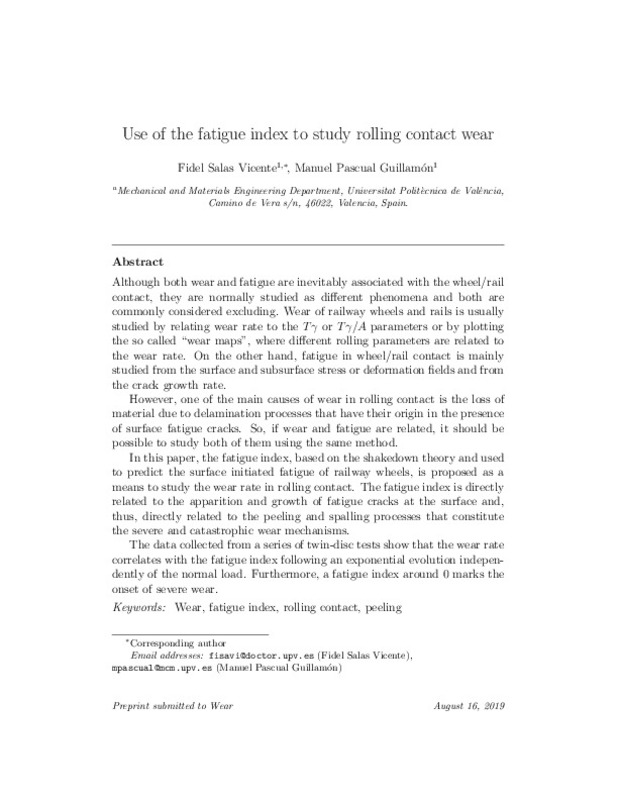JavaScript is disabled for your browser. Some features of this site may not work without it.
Buscar en RiuNet
Listar
Mi cuenta
Estadísticas
Ayuda RiuNet
Admin. UPV
Use of the fatigue index to study rolling contact wear
Mostrar el registro sencillo del ítem
Ficheros en el ítem
| dc.contributor.author | Salas Vicente, Fidel
|
es_ES |
| dc.contributor.author | Pascual Guillamón, Manuel
|
es_ES |
| dc.date.accessioned | 2020-05-14T03:04:26Z | |
| dc.date.available | 2020-05-14T03:04:26Z | |
| dc.date.issued | 2019-10-15 | es_ES |
| dc.identifier.issn | 0043-1648 | es_ES |
| dc.identifier.uri | http://hdl.handle.net/10251/143128 | |
| dc.description.abstract | [EN] Although both wear and fatigue are inevitably associated with the wheel/rail contact, they are normally studied as different phenomena and both are commonly considered excluding. Wear of railway wheels and rails is usually studied by relating wear rate to the T gamma or T gamma/A parameters or by plotting the so called "wear maps", where different rolling parameters are related to the wear rate. On the other hand, fatigue in wheel/rail contact is mainly studied from the surface and subsurface stress or deformation fields and from the crack growth rate. However, one of the main causes of wear in rolling contact is the loss of material due to delamination processes that have their origin in the presence of surface fatigue cracks. So, if wear and fatigue are related, it should be possible to study both of them using the same method. In this paper, the fatigue index, based on the shakedown theory and used to predict the surface initiated fatigue of railway wheels, is proposed as a means to study the wear rate in rolling contact. The fatigue index is directly related to the apparition and growth of fatigue cracks at the surface and, thus, directly related to the peeling and spalling processes that constitute the severe and catastrophic wear mechanisms. The data collected from a series of twin-disc tests show that the wear rate correlates with the fatigue index following an exponential evolution independently of the normal load. Furthermore, a fatigue index around 0 marks the onset of severe wear. | es_ES |
| dc.language | Inglés | es_ES |
| dc.publisher | Elsevier | es_ES |
| dc.relation.ispartof | Wear | es_ES |
| dc.rights | Reserva de todos los derechos | es_ES |
| dc.subject | Wear | es_ES |
| dc.subject | Fatigue index | es_ES |
| dc.subject | Rolling contact | es_ES |
| dc.subject | Peeling | es_ES |
| dc.subject.classification | CIENCIA DE LOS MATERIALES E INGENIERIA METALURGICA | es_ES |
| dc.title | Use of the fatigue index to study rolling contact wear | es_ES |
| dc.type | Artículo | es_ES |
| dc.identifier.doi | 10.1016/j.wear.2019.203036 | es_ES |
| dc.rights.accessRights | Abierto | es_ES |
| dc.contributor.affiliation | Universitat Politècnica de València. Departamento de Ingeniería Mecánica y de Materiales - Departament d'Enginyeria Mecànica i de Materials | es_ES |
| dc.description.bibliographicCitation | Salas Vicente, F.; Pascual Guillamón, M. (2019). Use of the fatigue index to study rolling contact wear. Wear. 436-437:1-9. https://doi.org/10.1016/j.wear.2019.203036 | es_ES |
| dc.description.accrualMethod | S | es_ES |
| dc.relation.publisherversion | https://doi.org/10.1016/j.wear.2019.203036 | es_ES |
| dc.description.upvformatpinicio | 1 | es_ES |
| dc.description.upvformatpfin | 9 | es_ES |
| dc.type.version | info:eu-repo/semantics/publishedVersion | es_ES |
| dc.description.volume | 436-437 | es_ES |
| dc.relation.pasarela | S\392878 | es_ES |







![[Cerrado]](/themes/UPV/images/candado.png)

